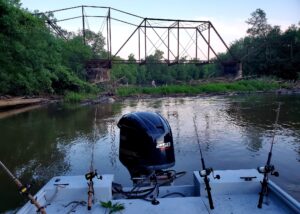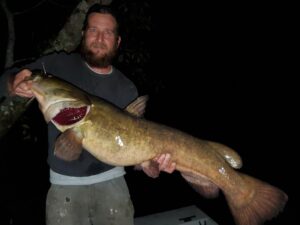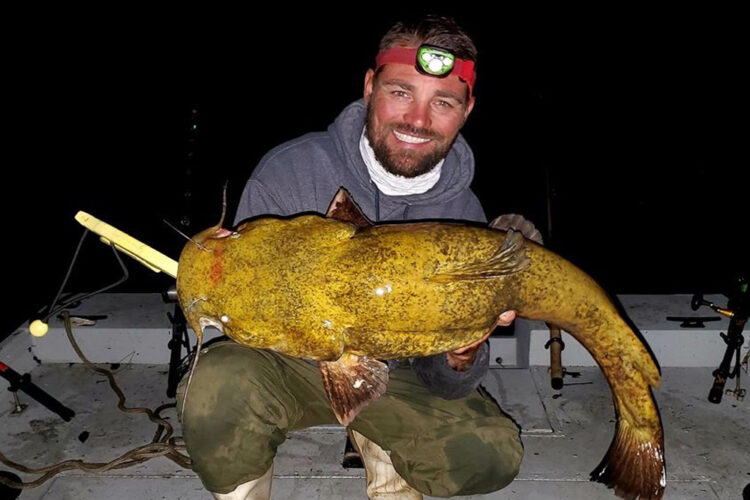The first flathead of the night often comes just after the sun goes down.
April Flatheads
by Capt. Glenn Flowers
Once the water temperatures begin to rise, lethargic flatheads begin to move and bring springtime action to anglers.
For many of us in the south, April brings hungry flatheads. After a long Winter, the April sun has warmed the water and put top predators like flatheads on the move once again.
Flatheads are very much reptilian-like in their ways. Unlike the flatheads up north, southern flatheads don’t go completely dormant. But they do slow their metabolism way down like a lizard, they become lethargic to save energy. They can often go for long periods without needing to feed.
Southern Flatheads
Southern flatheads reserve energy by taking advantage of shad kills. Winter shad kills keep large catfish fed and nourished throughout the coldest days. The harsh winter brings bait die-offs that lethargic flatheads eagerly take advantage of.

April flatheads require using just as much cut bait as live bait to be successful. On many trips, we don’t even bring live bait. The only baits we use are butterflied bluegill or cut skipjack herring.
Live baits will always catch flatheads, even under the worst conditions. However, we prefer to kill our live baits before tossing them out during the spring run. Often shad is difficult to come by in my home rivers so I tend to bring along baits like bluegills, various sunfish, and large river shiners. I don’t bring bullheads until the spawn ends after June.
Another interesting fact about April flatheads is that they become highly mobile, in other words, they are migrating. When they are on the move in April we catch flatheads in some of the oddest locations as they move from place to place.
Typically when you think of flathead fishing you plan a strategy related to structure. We will target jams too, but during April when flatheads are on their way to spawning areas we have found that if we set up to intercept these fish as they move we can catch them one after another.
It’s not uncommon to catch 25-30 flatheads in a single trip. Many fish will exceed the 40-pound range when fishing in their travel zones. In between deep river bends, there are long straightaways that we call funnel points. These are areas that flatheads use to travel back and forth from feeding areas and make an excellent ambush point.
If I were to pick the perfect condition to plan a spring flathead trip I would start by checking the moon phase. For best results, we always look for dark moons. The darker the better. New moons are ideal. We do catch flathead on big moons as well but the difference is literally night and day.

The second factor I would look at is the river height. During the spring, rivers often run high from spring rains in the south and snow melts up north. A fast-falling river is the worst scenario for flatheads. A stable flow with a moderate rise would be best. Remember, when the rivers fall, the flatheads rest and digest.
Another factor that I take into consideration when planning spring flathead trips is cold fronts. I try to avoid fishing the day after a front has passed. More often than not the unstable pressures will lead the flatheads to become very lethargic and uncooperative.
Anglers can catch daytime flatheads, but April is pre-spawn season in most destinations and I like to fish them at night. Spending a night on the river can leave anglers feeling exhilarated. The noises the flatheads make during the night are ear-numbing as flatheads shatter the shorelines. Sitting in the dark and listening to the chaos as flatheads unleash havoc on unsuspecting prey is something you can’t stop thinking about.
The rods and reels I use today are practically saltwater reels. They are capable of holding the heavy line needed to extract large flatheads from heave timber. The hook and weight will vary widely depending on river conditions and baits of choice. I’ve learned to never underestimate a big flathead.
Northern Flatheads
Spring comes a little later in our northern waters and leave flatheads susceptible to long periods of cold weather. Nevertheless, northern anglers are thinking about the approaching flathead bite.

“After a long winter, we are waiting for our flatheads to wake up for the season,” explained Illinois flathead angler Eric Carlson. “Depending on how our winter went, the flatheads start moving mid to late April. As spring approaches and the temps start to rise the flatheads start to bite again. We don’t really expect the good bite until May.”
Carlson commented, that after the long wait for spring to come, the much-anticipated flathead bite has most fisherman willing to try anything to get one. While many northern anglers prefer live or cut bait for flatheads, Eric noted that he sometimes catches flatheads on jigs, cranks, and other lures. (See Tips for Catching Flatheads from Float Tubes – Part 2 in this issue of CatfishNOW)
“The fish that are caught will have a muddy slick on them,” observed Carlson. “The mud is from their chosen wintering hole. The fish haven’t moved much at all during the winter so they can be sluggish and slow to bite.”
Bait is important to catch sluggish flatties. In their condition, they are not going to run down a lively bait. Carlson prefers a slow and listless live bait. He slows his live bait down by removing fins. Fresh-cut shad is also good bait for sluggish flatheads.
“Flatheads are not caught consistently in April,” Carlson said. “They are rare but not unheard of. April here is still considered the off-season for full-time flathead fishing. We still love trying and after our first couple of fish we know it’s on for the season, we don’t catch a lot but we love catching April flatheads.”
Final Thoughts
I’ve been hunting flatheads and studying their movements for going on 20 years now. My tactics and tackle evolve every year as I dial in on my prey. For any angler to become the best flathead hunter they can requires that they never stop learning. I’m always reading up on new tactics and strategies from any source I can get my hands on.



